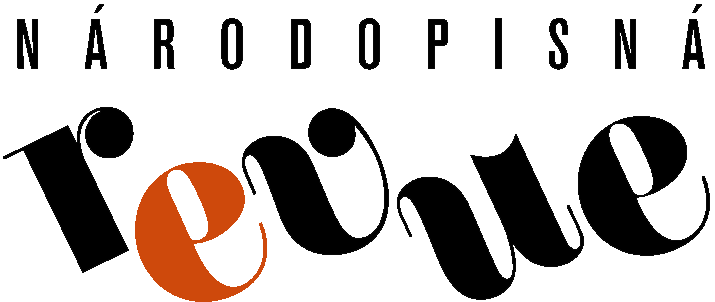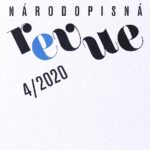Journal of Ethnology 4/2020 deals with the theme “Folklorism of the 21st Century”. Teresa Smolińska focusses on cultural traditions of the German minority living in Upper Silesia in Poland (Modern Cultural Traditions of the Germans in Silesia: towards folklorism). Andrej Mentel deals with the cultural memory in Bosnia and Herzegovina and its strengthening based on newly composed folk music (Folklorism and Culture of Memory in Contemporary Bosnia and Herzegovina). Jiří Čevela presents the research into cimbalom music bands in the Uherské Hradiště area (Contemporary Tendencies of Cimbalom Music Bands in the Uherské Hradiště Area) and Jarmila Teturová submits the research into the current condition of the verbuňk dance in the ethnographic area of Podluží (The Influence of the Contest for the Best Dancer of Slovácko Verbuňk on the Existence and Form of the Verbuňk Dance in the Ethnographic Area of Podluží). Bronislav Stupňánek and Martina Ireinová write about current expressions of dialects in the ethnographic area of Haná (The Second Life of Dialects: Central Middle-Moravian Dialects Used in Public Speaking, and the “Hanakian Revival”).
The Transforming Tradition column pays attention to the Slovácko verbuňk dance as an expression of folklorism (written by Anna Jagošová). Review Section commemorates the 100th anniversary of the birth of the folklorist Antonín Satke (written by Jana Pospíšilová). Social Chronicle remembers the jubilees of the ethnologist Jan Krist (born 1950), the cultural anthropologist Zdeněk Salzmann (born 1925), and the cultural professional and choreographer Eva Rejšková (born 1930); it publishes an obituary for the Slovak folklorist and ethnologist Ján Michálek (1932-2020). Further regular columns include reports on conferences and disciplinary projects, and reviews of new books.
Modern Cultural Tradition of the Germans in Silesia: Towards Folklorism
The authoress focuses her research on the spontaneous development of specific cultural events among the Germans in Upper Silesia, which testifies to the increase in their sense of value of their own culture and to changes in their manifestation of national awareness and identity. They try to reconstruct many forms of German cultural heritage in this region that serve already different functions in the contemporary culture and, therefore, they are typical of folklorism, i.e. popular culture. The revival of ‘German folk tradition’ after the political transformation in Poland in 1989 is stimulated not only by artistic folk groups but also by individuals who copy selected parts of traditional middle-class culture in Germany, e.g. Martinfest, Oktoberfest, Weihnachtsmarkt, Rosenmontag, and popularise their trivialised forms in which ludic and integrative functions prevail. The Easter Bunny (Osterhase) deserves a special mention in post-war Upper Silesia. Searching for gifts brought by the Easter Bunny, so popular among the indigenous inhabitants of this region, may be regarded as a regional ‘lesson’ to be learnt but it lacks, however, the place for remembrance of old spring rites and magic rituals associated with them. Having only a superficial nature and serving a ludic function, the reconstruction meets all the criteria of folklorism, which shows that consumerist culture exerts an overwhelming influence. Amongst the parties fashionable recently that are organised by young women in several towns in Opole Silesia, where German minorities tend to predominate, the authoress points to Rosenmontag, i.e. a costume ‘ball’ aspiring – despite little similarity – to traditional carnival parades in German cities (Köln, Mainz, Düsseldorf). Both examples selected from the German heritage (Rosenmontag) and presented against other forms of German tradition preserved in Silesia accurately represent the folklorisation of the tradition.
Folklorism and Culture of Memory in Contemporary Bosnia and Herzegovina
Diverse aspects of folklorism in the countries of former Yugoslavia are a subject-matter of long-term ethnologic and folkloristic research. One of the important themes touches the relation between newly composed folk music (NCFM) and aggressive nationalistic propaganda, as well as further aspects of this genre. The NCFM is a genre of commercial music that developed in the former Yugoslavia from the 1960s and that refers to folk sources in its texts and musical construction. In Bosnia and Herzegovina, it was sevdalinka, a specific genre of urban music folklore, that have become one of NCFM sources. Sevdalinka has become one of the elements of the “orientalising” hetero-stereotypes of Bosniaks and Bosnian Muslim culture as the one that “essentially differs” from the cultures of other nations living in the former Yugoslavia. It has been insufficiently researched to date how the Bosniak collective memory is currently constructed through the NCFM. On an example of particular commemorative events, the study shows how a certain image of Bosniak history is created and supported by using the NCFM.
Contemporary Tendencies of Cimbalom Music Bands in the Uherské Hradiště Area
The study deals with the reflection of contemporary tendencies of cimbalom music bands in the Uherské Hradiště area. It informs about artistic approaches, forms of presentation, as well as about the character of activities of thirty-seven cimbalom music bands, which work in the Uherské Hradiště area (ethnographic area of Slovácko). This region, the ethnographic boundaries of which are defined at the beginning of the text, is considered to be promising for the above-mentioned reflection mainly due to the long-term tradition and the number of cimbalom music bands. Against the background of the cultural and historical development in the Uherské Hradiště area, it is possible to observe different tendencies in music bands´ approach to the folk song, and in their societal engagement, which are two perspectives, crucial for the typologization. Within these perspectives, the author defines six tendencies which mingle and supplement each other in musical attitude and productions of particular cimbalom music bands. From the perspective of the approach to the folk song, three general tendencies are elaborated – reconstruction, stylization, and fusion of genres. The societal engagement includes cooperation with groups which are active in folklorism, concerts, and spontaneous music-making, whereby these tendencies show different intensity of commercialization.
The Influence of the Contest for the Best Dancer of Slovácko Verbuňk on the Existence and Form of the Verbuňk Dance in the Ethnographic Area of Podluží
The study submits results of the first stage of research on the influence of the Contest for the Best Dancer of Slovácko verbuňk on the existence and form of the verbuňk dance with focus on the current situation in the ethnographic area of Podluží. The Contest has been organized at the International Folklore Festival Strážnice every year since 1986, and since 2005 is has been part of safeguarding measures for verbuňk as an element inscribed on the UNESCO Representative List of the Intangible Cultural Heritage of Humanity. The authoress presents results of field search conducted among three groups of respondents in Podluží, meaning contemporaries (former dancers regardless their participation in the Contest), local authorities directly connected with the Contest (successful participants in the Contest), and young active dancers who dance verbuňk at the Contest and also at usual dance occasions. Respondents´ opinions prove the influence of the Contest on the popularization and promotion of verbuňk in the field, and they draw attention to the issue of interventions in the natural development of regional style. The mentioned findings will be used to compare results from further stages of the research, which are conducted in other sub-regions of the ethnographic area of Slovácko.
The Second Life of Dialects: Central Middle-Moravian Dialects Used in Public Speaking and the “Hanakian Revival”
Since the turn of the 21st century, a considerably increasing interest in local dialects in Czech regions with traditionally strong regional identity can be observed. This interest seems to be a response to the current rapid decline of dialects and deep disparity between languages spoken by the oldest and the youngest generations. The reaction thereon includes active efforts to maintain or even renew the dialects. However, it is private spoken communication that is the most natural field for dialects and therefore the effort for public coverage and the appeal to wide regional audience inevitably leads to the fact that the dialects get into the context and functions which are not typical for them or which are completely new (dialect textbooks and courses, websites and news portals in dialects, dialect texts of songs from modern musical genres etc.). Although this phenomenon shares common features in almost the entire territory of our traditional territorial dialects, the most frequent occurrence of it can be observed in the area where central Middle-Moravian dialects are spoken. In accordance with the explicitly expressed intention of those who spread the dialects in this region, the authors of the study call the above-mentioned phenomenon “the Hanakian Revival”.



